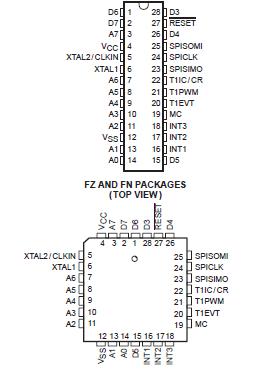Features: Low-Power Modes: STANDBY and HALT
Commercial, Industrial, and Automotive Temperature Ranges
Clock Options
Divide-by-1 (2 MHz5 MHz SYSCLK) Phase-Locked Loop (PLL)
Divide-by-4 (0.5 MHz5 MHz SYSCLK)
Supply Voltage (VCC) 5 V ±10%Pinout Specifications
Specifications
|
Supply voltage range,VCC (see Note 1) |
0.6 V to 7 V |
|
Input voltage range, All pins except MC
MC |
0.6 V to 7 V |
|
0.6 V to 14 V |
|
Input clamp current, IIK (VI < 0 or VI > VCC) |
±20 mA |
|
Output clamp current, IOK (VO < 0 or VO > VCC) |
±20 mA |
|
Continuous output current per buffer, IO (VO = 0 to VCC) (see Note 2) |
±10 mA |
|
Maximum ICC current |
170 mA |
|
Maximum ISS current |
-170 mA |
|
Continuous power dissipation |
500 mW |
|
Operating free-air temperature range, TA: L version
A version
T version |
0°C to 70°C |
|
40°C to 85°C |
|
40°C to 105°C |
|
Storage temperature range, Tstg |
65°C to 150°C |
† Stresses beyond those listed under "absolute maximum ratings" may cause permanent damage to the device. These are stress ratings only, and functional operation of the device at these or any other conditions beyond those indicated under "recommended operating conditions" is not implied. Exposure to absolute-maximum-rated conditions for extended periods may affect device reliability.
NOTES: 1. Unless otherwise noted, all voltage values are with respect to VSS.
2. Electrical characteristics are specified with all output buffers loaded with specified IO current. Exceeding the specified IO current in any buffer can affect the levels on other buffers.
DescriptionThe TMS370C712B, TMS370C012, TMS370C311, TMS370C310, TMS370C312, TMS370C712, and SE370C712 devices are members of the TMS370 family of single-chip 8-bit microcontrollers. Unless otherwise noted, the term TMS370Cx1x refers to these devices. The TMS370 family provides cost-effective real-time system control through integration of advanced peripheral-function modules and various on-chip memory configurations.
The TMS370C712B family of devices is implemented using high-performance silicon-gate CMOS EPROM and EEPROM technologies. Low-operating power, wide-operating temperature range, and noise immunity of CMOS technology coupled with the high performance and extensive on-chip peripheral functions make the TMS370Cx1x devices attractive for system designs for automotive electronics, industrial motors, computer peripheral controls, telecommunications, and consumer applications.
All TMS370C712B devices contain the following on-chip peripheral modules:
` Serial peripheral interface (SPI)
` One 24-bit general-purpose watchdog timer
` One 16-bit general-purpose timer with an 8-bit prescaler
The TMS370C712B family provides two low-power modes (STANDBY and HALT) for applications where low-power consumption is critical. Both modes stop all CPU activity (that is, no instructions are executed). Inthe STANDBY mode, the internal oscillator and the general-purpose timer remain active. In the HALT mode,all device activity is stopped. The device retains all RAM data and peripheral configuration bits throughout both low-power modes.
The TMS370Cx1x features advanced register-to-register architecture that allows direct arithmetic and logical operations without requiring an accumulator (for example, ADD R24, R47; add the contents of register 24 to the contents of register 47 and store the result in register 47). The TMS370Cx1x family is fully instruction-set-compatible, providing easy transition between members of the TMS370 8-bit microcontroller family.
The SPI provides a convenient method of serial interaction for high-speed communications between simpler shift register-type devices, such as display drivers, analog-to-digital (A/D) converters, PLL, input/ output (I /O) expansion, or other microcontrollers in the system.
The TMS370Cx1x family provides the system designer with economical, efficient solution to real-time control applications. The TMS370 family extended development system (XDSTM) and compact development tool (CDTTM) solve the challenge of efficiently developing the software and hardware required to design the TMS370Cx1x into an ever-increasing number of complex applications. The application source code can be written in assembly and C language, and the output code can be generated by the linker. The TMS370 family XDS development tool communicates through a standard RS-232-C interface with an existing personal computer. This allows the use of the PC's editors and software utilities already familiar to the designer. The TMS370 family XDS emphasizes ease-of-use through extensive menus and screen windowing so that a system designer can begin developing software with minimal training. Precise real-time, in-circuit emulation and extensive symbolic debug and analysis tools ensure efficient software and hardware implementation as well as reducing the time-to-market cycle.
The TMS370Cx1x family together with the TMS370 family XDS22, CDT370, design kit, starter kit, software tools, the SE370C712 reprogrammable devices, comprehensive product documentation, and customer support provide a complete solution to the needs of the system designer.

 TMS370C712B Data Sheet
TMS370C712B Data Sheet







